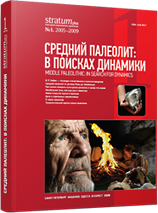Позднепалеолитическая и мезолитическая экономика при отсутствии местных сырьевых ресурсов (по материалам Нижнеднепровско-Присивашского района)
Upper Palaeolithic and Mesolithic Economy in the Absence of Local Raw Material Resources
Author(s): Nikolai P. OlenkovskySubject(s): History, Archaeology, Economic history
Published by: Издательский дом Stratum, Университет «Высшая антропологическая школа»
Keywords: raw material; Mesolithic Economy; Local Raw Material Resources;
Summary/Abstract: In the absence of flint raw material traditional for production tools at habitation territory, the Palaeolithic and Mesolithic man had to find the way out either by choosing other kinds of raw materials or by organizing delivery of the flint raw material from other regions.The author examines one of the regions of Eastern Europe, the Lower Dnieper region, as a case of a specific tendency in ancient population’s survival solutions given the total lack of raw material. The sum of facts on the Palaeolithic and Mesolithic sites of the region shows two solutions of the problem of lacking raw material. First, there were exclusive requirements to the content and quality of the rock raw material. Second, there was a thorough economy in using the raw material. Analysis of materials from every Upper Palaeolithic (153) and Mesolithic (nearly 100) site of the region clearly shows absolute priority given to imports of high-quality flint to this region.The study has shown diverse economic usages of the imported raw material in the examined region. First of all, it is clearly seen that blades and flakes were massively used as blanks for production of tools with secondary processing. The economy of raw material increases not only by utilization of full cores, but also by using chips, which otherwise, with sufficient provision of raw material, were either entirely or to a considerable degree disposed of as a “factory waste”. A higher percentage of primary flakes and crested blades is traceable. Burin facets and chips began to be used as blanks. And, finally, a considerable economy of raw materials was reached by a heavy reduction in size of blanks and all categories and types of tools.
Journal: Stratum plus. Археология и культурная антропология
- Issue Year: 2009
- Issue No: 1
- Page Range: 243-252
- Page Count: 10
- Language: Russian
- Content File-PDF

